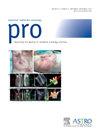Consensus Guidelines for Delineation of Clinical Target Volumes for Intensity Modulated Radiation Therapy for Intact Cervical Cancer: An Update
IF 3.4
3区 医学
Q2 ONCOLOGY
引用次数: 0
Abstract
Purpose
Accurate target delineation is essential when using intensity modulated radiation therapy for intact cervical cancer. In 2011, the Radiation Therapy Oncology Group published a consensus guideline using magnetic resonance imaging (MRI). The current project expands on the previous atlas by including computed tomography (CT)-based contours, contours with MRI and positron emission tomography (PET) registrations, the addition of common and complex scenarios, and incorporating information on simulation and treatment planning techniques.
Methods and Materials
Twenty-eight experts in gynecologic radiation oncology contoured 3 cases, first on a noncontrast CT simulation scan and then with registered diagnostic scans. The cases included (1) International Federation of Gynecology and Obstetrics (FIGO) IIIC1 with a bulky tumor and vaginal metastasis, (2) FIGO IIB with calcified uterine fibromas, and (3) FIGO IIIC2 with large lymph nodes. The contours on all 6 data sets (3 CT simulations without diagnostic images and 3 with registered images) were analyzed for consistency of delineation using an expectation-maximization algorithm for simultaneous truth and performance level estimation with kappa statistics as a measure of agreement. The contours were reviewed, discussed, and edited in a group meeting prior to finalizing.
Results
Contours showed considerable agreement among experts in each of the cases, with kappa statistics from 0.67 to 0.72. For each case, diagnostic PET ± MRI was associated with an increase in volume. The largest increase was the clinical target volume (CTV) primary for case 2, with a 20% increase in volume and a 54% increase in simultaneous truth and performance level estimation volume, which may be due to variance in registration priorities. For the third case, 92.9% increased their CTVs based on the addition of the diagnostic PET scan. The main areas of variance were in determining the superior extent of CTV coverage, coverage of the mesorectum, and simulation and planning protocols.
Conclusions
This study shows the value and the challenges of using coregistered diagnostic imaging, with an average increase in volumes when incorporating MRI and PET.
宫颈癌调强放射治疗临床靶区划分共识指南》:更新版。
目的:在使用调强放射治疗(IMRT)治疗完整的宫颈癌时,准确的靶区划分至关重要。2011 年,放射治疗肿瘤学组 (RTOG) 发布了一份使用磁共振成像 (MRI) 的共识指南。目前的项目在之前地图集的基础上进行了扩展,包括基于计算机断层扫描(CT)的轮廓图、磁共振成像和正电子发射断层扫描(PET)登记的轮廓图,增加了常见和复杂的情况,并纳入了模拟和治疗计划技术的信息:28 位妇科放射肿瘤学专家对三个病例进行了轮廓分析,首先是非对比 CT 模拟扫描,然后是注册诊断扫描。病例包括:(1) FIGO IIIC1,肿瘤巨大且有阴道转移;(2) FIGO IIB,子宫纤维瘤钙化;(3) FIGO IIIC2,淋巴结较大。对所有六个数据集(三个不带诊断图像的 CT 模拟和三个带注册图像的数据集)上的轮廓进行了分析,采用期望最大化算法进行同步真相和性能水平估计 (STAPLE),以卡帕统计作为衡量一致性的标准。在最终确定轮廓之前,小组会议对轮廓进行了审查、讨论和编辑:结果:在每个病例中,专家之间的等值线显示出相当大的一致性,kappa 统计量为 0.67-0.72。在每个病例中,诊断性 PET±MRI 都与体积的增加有关。增加最多的是病例 2 的 CTV 基底,体积增加了 20%,STAPLE 估计体积增加了 54%,这可能是由于登记优先级的差异造成的。对于第三个病例,92.9%的人在增加诊断性 PET 扫描的基础上增加了 CTV。存在差异的主要方面是确定CTV覆盖的优势范围、直肠中叶的覆盖范围以及模拟和规划方案:这项研究显示了使用联合注册诊断成像的价值和挑战,当结合 MRI 和 PET 时,平均体积会增加。
本文章由计算机程序翻译,如有差异,请以英文原文为准。
求助全文
约1分钟内获得全文
求助全文
来源期刊

Practical Radiation Oncology
Medicine-Radiology, Nuclear Medicine and Imaging
CiteScore
5.20
自引率
6.10%
发文量
177
审稿时长
34 days
期刊介绍:
The overarching mission of Practical Radiation Oncology is to improve the quality of radiation oncology practice. PRO''s purpose is to document the state of current practice, providing background for those in training and continuing education for practitioners, through discussion and illustration of new techniques, evaluation of current practices, and publication of case reports. PRO strives to provide its readers content that emphasizes knowledge "with a purpose." The content of PRO includes:
Original articles focusing on patient safety, quality measurement, or quality improvement initiatives
Original articles focusing on imaging, contouring, target delineation, simulation, treatment planning, immobilization, organ motion, and other practical issues
ASTRO guidelines, position papers, and consensus statements
Essays that highlight enriching personal experiences in caring for cancer patients and their families.
 求助内容:
求助内容: 应助结果提醒方式:
应助结果提醒方式:


